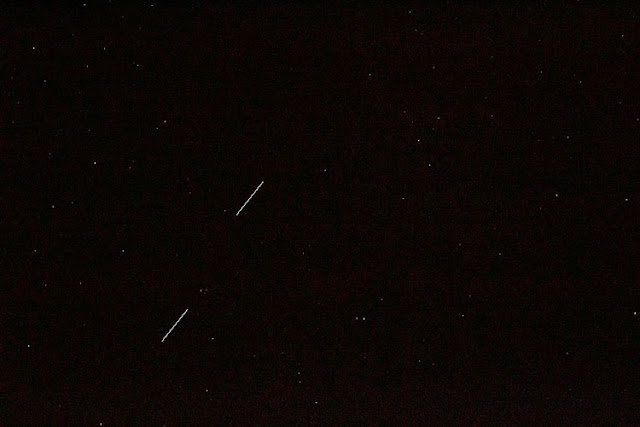Well here we are on Saturday morning waiting for our next chance to get some more images of the Starlink satellites before they disperse into their assigned positions. This image from is what I hoped to get again, minus the trees.
 |
| String of pearls configuration of Starlink satellites, 135 mm, 0.5 seconds, 11/12/19 (Source: Palmia Observatory) |
So, I'm outside at about 4:30 AM, setting up and waiting for the Starlink satellites to pass overhead. Resident Astronomer Peggy elected to stay snuggled up in bed, but by chance I was joined outside by Mina's Guardians, Amir and Lou Ann, while we waited, with coffee cups in hand. This was a lucky meeting because it was Lou Ann's eyeballs that first spotted the line of Starlink satellites. Thanks for that, Lou Ann!
While we waited, I focused the camera on a bright star and then took one test image of a passing aircraft just to prove that the red dot finder was aligned. Check out this 1/2 second, 105 mm, telephoto image of the aircraft. The navigation lights are visible and you can effects of, what I assume, turbulence around the aircraft flight path.
 |
| Practice shot of aircraft overhead, 105 mm, DSLR telephoto, 1/2 second (Source: Palmia Observatory) |
Check out this expanded view of the photo of the aircraft navigation lights. Using Photoshop we can measure how fast the airplane is moving, which turns out to be 12.3 * 326 / 5157 = 0.78 degrees over the 1/2 second exposure. We would have to know the slant range and angle to actually calculate the speed of the aircraft.
You can really see the lights really moving around. Is the aircraft really that unstable? Probably not, but maybe the effect is due to different air characteristics along the flight path? As we will see, shortly, we need to ask the same question about the close up view of the satellites.
 | |
|
We knew the approximate sky location to look using the sky charts from Heavens-Above. The first satellite of the constellation of 60 satellites was predicted to pass overhead at about 4:37 AM, PST. You can see the starting and ending position in the sky chart below.
 |
| Sky chart for the first of the Starlink satellites for November 23 in Orange County (Source: www.heavens-above.com) |
Then bring up the rear we expected to see the last of the constellation at 5:11 AM PST. Note how during this 34 minute interval how much the location in the sky has changed. The orbit of the satellites has not changed but the Earth would have rotated about 15 * 34 / 60 = 8.5 degrees and the satellites themselves are moving along at much higher velocity.
 | |
|
 |
| Two Starlink satellites visible in this DSLR, 105 mm telephoto, 1 second image (Source: Palmia Observatory) |
The previous image was also uploaded to Astrometry.net to get the actual sky location. This location can then be compared with the predicted location, but that is a separate task. I did, however, use the computed size of the image, 12.3 x 8.21 degrees, to estimate how fast the satellites were moving across the sky. Using Photoshop the width of the image was 1484 units and the length of the satellite track was 92 units. So during the 1 second exposure, the satellite moved 12.3 * 92 / 1484 = 0.76 degrees. We can't translate that angular motion into the actual satellite velocity without more data.
 |
| Using Astrometry.net to identify sky location of the satellites (Source: Palmia Observatory) |
It is also interesting to expand the view of the satellites and take a look at how its path seems to wobble all around. The stationary stars don't seem to wobble around that much and the satellite orbit is not wobbling. But the effect might still be due to atmospheric turbulence since the satellite, because it is moving, its image is seen through a different and more varying atmospheric path than the star. It could be maybe tumbling of the satellite, which could affect the amount of light received, but that seems unlikely because the satellite attitude is probably being controlled. Yep, it seems to me that the effect is due to atmospheric turbulence. What say the rest of you observers?
Several OCA members, including Bill W. and Science Nerd, Scott, commented that the wobble is mostly likely due to tripod wobble. I was using a lightweight flimsy tripod and trying to follow a fast moving aircraft introduces more motion and I didn't wait long for the tripod to settle down. Hmm, after looking at the aircraft lights and seeing how they all seem to wiggle in the same direction at the same time seems to point toward tripod wobble. Thanks for the feedback, everyone!
 | |
|
Until next time,
Resident Astronomer George
Be sure to check out over 300 other blog posts on similar topics
If you are interested in things astronomical or in astrophysics and cosmology
Check out this blog at www.palmiaobservatory.com

No comments:
Post a Comment